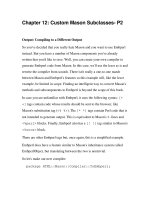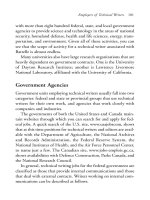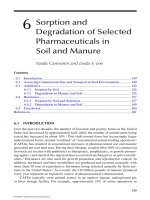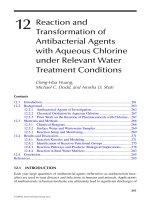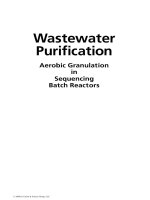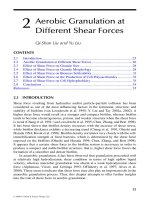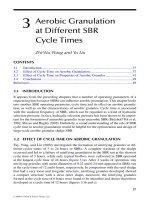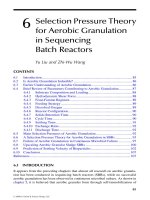Wastewater Purification: Aerobic Granulation in Sequencing Batch Reactors - Chapter 12 pptx
Bạn đang xem bản rút gọn của tài liệu. Xem và tải ngay bản đầy đủ của tài liệu tại đây (3.31 MB, 14 trang )
209
12
Biodegradability of
Extracellular Polymeric
Substances Produced
by Aerobic Granules
Zhi-Wu Wang and Yu Liu
CONTENTS
12.1 Introduction 209
12.2 Biodegradability of EPS Extracted from Aerobic Granules 210
12.2.1 Biodegradability of EPS Extracted from Fresh
Aerobic Granules 210
12.2.2 Biodegradability of EPS Extracted from Starved
Aerobic Granules 212
12.2.3 Comparison of Biodegradability of Acetate and Extracted EPS 212
12.3 Biodegradation of Aerobic Granule-Associated EPS during Starvation 214
12.4 EPS Biodegradation in an Aerobic Granular Sludge SBR 216
12.5 Origin of Biodegradable Aerobic Granules-Associated EPS 218
12.6 Conclusions 220
References 221
12.1 INTRODUCTION
The essential role of extracellular polymeric substances (EPS) in the formation
ofbiolm,anaerobicandaerobicgranuleshasbeenwelldocumentedsofar(see
taining the spatial structure of immobilized microbial communities, it should not be
biodegraded by their own producer, that is, EPS-producing organisms are unable to
utilizetheirownEPSascarbonsource(ObayashiandGaudy1973;Dudman1977;
Pirogetal.1977;Sutherland1999).Onthecontrary,increasingevidenceshowsthat
EPScouldbereadilybiodegradablefortheirownproducers(PatelandGerson1974;
BoydandChakrabarty1994;Nielsen,Frolund,andKeiding1996;Ruijssenaars,
Stingele, and Hartmans 2000; Zhang and Bishop 2003; Decho, Visscher, and Reid
2005). The EPS distribution in aerobic granules has been presented in chapter 11,
showing that a substantial portion of the EPS accumulated at the center of aerobic
granulescanbeutilizedovera20-daystarvationperiod,andtheinternalstructureof
aerobic granules becomes hollow compared to the structure of fresh aerobic granules.
53671_C012.indd 209 10/2/07 2:07:31 PM
© 2008 by Taylor & Francis Group, LLC
© 2008 by Taylor & Francis Group, LLC
chapter9).AsEPShasbeenbelievedtoplayanessentialroleinbuildingandmain-
210 Wastewater Purification
In complement to chapter 11, this chapter specically reviews the biodegradability
ofEPSproducedbyaerobicgranulesaswellasitscontributiontothestabilityof
aerobic granules.
12.2 BIODEGRADABILITY OF EPS EXTRACTED FROM
AEROBIC GRANULES
To investigate the biodegradability of EPS produced by aerobic granules, Wang,
Liu,andTay(2007)extractedEPSfromfreshandstarvedaerobicgranules,and
theextractedEPS,asthesolecarbonsource,wasthenfedtothebatchcultureof
prestarved aerobic granules. Such an experimental design can minimize the interfer
-
enceofEPSstoredinfreshaerobicgranules.
12.2.1 BIODEGRADABILITY OF EPS EXTRACTED FROM FRESH AEROBIC GRANULES
Figure 12.1 shows the biodegradation proles of the extracted EPS in terms of
polysaccharides (PS) and proteins (PN) observed in the course of the batch culture
ofprestarvedaerobicgranules.ArapidbiodegradationofbothPSandPNwas
observedintherst10hoursofthecultureuntilastationaryphasewasachieved.It
canbeseenthatnearly50%ofPSwasutilizedbyitsownproducersastheexternal
carbon source, while only 30% of PN was consumed together with PS. According
to gure 12.1, the average linear biodegradation rates of PS and PN were estimated
as 15.2 mg PS g
–1
suspendedsolids(SS)d
–1
and14.8mgPNg
–1
SS d
–1
,respectively,
indicating that the biodegradation rates of both PS and PN are highly comparable.
Nielsen, Frolund, and Keiding (1996) investigated the biodegradability of EPS
producedfromactivatedsludgeduringanaerobicstorageprocess.Itwasfoundthat
the sludge EPS content quickly declined as a result of biodegradation, and the bio
-
degradable fraction of EPS accounted for about 40% of the total EPS (gure 12.2).
ThisgureappearstobeveryclosetothefractionofbiodegradableEPSproduced
Time (hours)
0 5 10 15 20 25 30
PS (mg L
–1
)
0
5
10
15
20
25
PN ( mg L
–1
)
0
5
10
15
20
25
FIGURE 12.1 BiodegradabilityofPS(O)andPN(/) extracted from fresh aerobic granules.
(From Wang, Z W., Liu, Y., and Tay, J H. 2007. Appl Microbiol Biotechnol 74:462–466.
With permission.)
53671_C012.indd 210 10/2/07 2:07:32 PM
© 2008 by Taylor & Francis Group, LLC
© 2008 by Taylor & Francis Group, LLC
Biodegradability of Extracellular Polymeric Substances 211
by aerobic granules (gure 12.1). In fact, EPS biodegradation under anaerobic condi-
tions has also been reported previously (Ryssov Nielsen 1975).
EPSproducedbynaturalbacteriawasalsofoundtocontainalargebiodegrad
-
able fraction. Decho, Visscher, and Reid (2005) extracted EPS from marine bacteria
thatliveinastromatolite,andlabeleditwithisotopecarbonas
14
C-EPS. Extraction
wasfedbacktoitsproducer,andthecarbonuxwasmonitored.AclearEPSbio-
degradation, indicated by the conversion of
14
C-EPS to
14
CO
2
,wasobservedinthe
courseof50minutesofcultivation(gure12.3).Itcanbeseenthatabout50%of
14
C-EPS was nally converted to
14
CO
2
. These results are in good agreement with
Time (days)
024681012
PS (mg g
–1
VSS)
10
15
20
25
30
35
40
45
PN (mg g
–1
VSS)
120
140
160
180
200
220
FIGURE 12.2 Change of activated sludge extracellular PS (D)andPN($)duringanaerobic
storage.(DatafromNielsen,P.H.,Frolund,B.,andKeiding,K.1996.Appl Microbiol
Biotechnol 44:823–830.)
Time (hours)
0 1020304050
Acummulative Mean Percent of Respired
14
CO
2
0
10
20
30
40
50
60
FIGURE 12.3 Biodegradation of
14
C-EPS into
14
CO
2
by marine bacteria. (Data from
Decho,A.W.,Visscher,P.T.,andReid,R.P.2005.Palaeogeogr Palaeoclimatol Palaeoecol
219: 71–86.)
53671_C012.indd 211 10/2/07 2:07:34 PM
© 2008 by Taylor & Francis Group, LLC
© 2008 by Taylor & Francis Group, LLC
212 Wastewater Purification
thosefoundinaerobicgranulesandactivatedsludgecultures(gures12.1and12.2).
Moreover,itisapparentthattheproductionofbiodegradableEPSshouldbeacom
-
monphenomenonbroadlyexistinginawidespectrumofmicroorganisms,andalso
the fraction of biodegradable EPS in the total EPS produced is generally around 50%
(gure 12.3).
12.2.2 BIODEGRADABILITY OF EPS EXTRACTED FROM STARVED AEROBIC GRANULES
Asshowningure12.1,nearly50%oftheEPSextractedfromfreshaerobicgran-
ules were nonbiodegradable in the batch culture of prestarved aerobic granules as
users. To conrm such an observation, the EPS extracted from the starved aerobic
granules were fed, as the sole carbon source, to the batch culture with the prestarved
aerobicgranules.Inthiscase,gure12.4showsnosignicantbiodegradationofthe
EPSextractedfromthestarvedgranule,indicatedbyaverylowaveragebiodegra
-
dation rate of 0.38 mg g
–1
SS d
–1
for PS and 0.75 mg g
–1
SS d
–1
for PN. These results
further conrm that EPS secreted by aerobic granules is basically made up of two
major components, that is, biodegradable and nonbiodegradable EPS according to
their biodegradability.
12.2.3 COMPARISON OF BIODEGRADABILITY OF ACETATE AND EXTRACTED EPS
Wang,Liu,andTay(2007)comparedbiodegradabilityofacetateandEPSextracted
fromthefreshandstarvedaerobicgranulesusingbatchcultures.Theinitialcon
-
centrationsofacetateandextractedEPSwerekeptat100mgCODL
–1
.Figure12.5
shows that the average biodegradation rates of acetate and EPS extracted from fresh
andstarvedaerobicgranuleswere5.4mgCODmg
–1
SS d
–1
,1.1mgCODmg
–1
SS h
–1
,
and 0.018 mg COD mg
–1
SS h
–1
, respectively. These results point to the fact that
bacteria would preferably utilize an external carbon source, such as acetate in this
case,wheneveritisavailable.However,afterdepletionoftheexternalcarbonsource,
Time (hours)
0 5 10 15 20 25 30
PS (mg L
–1
)
0
15
30
45
60
75
PN (mg L
–1
)
0
15
30
45
60
75
FIGURE 12.4 BiodegradabilityofPS(O)andPN(/) extracted from starved aerobic
granules.(FromWang,Z W.,Liu,Y.,andTay,J H.2007.Appl Microbiol Biotechnol
74:462–466.Withpermission.)
53671_C012.indd 212 10/2/07 2:07:35 PM
© 2008 by Taylor & Francis Group, LLC
© 2008 by Taylor & Francis Group, LLC
Biodegradability of Extracellular Polymeric Substances 213
thebiodegradationofEPSmayfurtherprovidetheminimumenergyrequiredfor
microbial maintenance functions during cell starvation.
Biodegradable EPS has been discovered in many forms of bacteria exploited for
environmental engineering. Zhang and Bishop (2003) extracted EPS from biolm
andfedittotheirownproducer,andfoundthatbothPSandPNcomponentsinEPS
continuously decreased over the culture time (gure 12.6). Once again it can be seen
ingure12.6thataround50%ofthetotalEPSproducedbybiolmsisbiodegrad
-
able, and the respective PS and PN utilization rate of 0.4 mg PS mg
–1
SS d
–1
and
0.3mgPNmg
–1
SS d
–1
were obtained. It appears from gure 12.1 (aerobic granules),
Time (h)
0 5 10 15 20 25 30
COD (mg L
–1
)
20
40
60
80
100
120
3
2
1
FIGURE 12.5 Biodegradability of acetate and EPS extracted from aerobic granules.
1: Acetate (+); 2: EPS extracted from the fresh granules ($); 3: EPS extracted from the starved
granules (D). (From Wang, Z W., Liu, Y., and Tay, J H. 2007. Appl Microbiol Biotechnol
74:462–466.Withpermission.)
Time (hours)
0 5 10 15 20 25
PS (mg g
–1
SS)
35
40
45
50
55
60
65
PN (mg g
–1
SS)
12
16
20
24
28
32
FIGURE 12.6 Biodegradation of PS (D)andPN($)bybiolm.(DatafromZhang,X.Q.and
Bishop,P.L.2003.Chemosphere 50: 63–69.)
53671_C012.indd 213 10/2/07 2:07:37 PM
© 2008 by Taylor & Francis Group, LLC
© 2008 by Taylor & Francis Group, LLC
214 Wastewater Purification
gure 12.2 (activated sludge), and gure 12.3 (natural bacteria) that the EPS pro-
ducedbyaerobicgranules,activatedsludge,andbiolmsaresimilarorcompara
-
bleinthesenseoftheirbiodegradability.Evidencethusfarfromaerobicgranules,
suspended activated sludge, and biolms all point to the fact that bacteria are able
tovigorouslytakeupEPSasanexternalfoodsourceinthecasewhereanexternal
carbon source is no longer available.
12.3 BIODEGRADATION OF AEROBIC GRANULE-ASSOCIATED
EPS DURING STARVATION
To investigate the biodegradation of aerobic granule-associated EPS, fresh aerobic
granules taken from a sequencing batch reactor (SBR), without pretreatment, were
subjectedtoaerobicstarvationwithoutadditionofanexternalcarbonsourcefor
20 days (Wang, Liu, and Tay 2007). The fresh aerobic granules had an initial specic
oxygen uptake rate (SOUR) of 62 mg O
2
g
–1
volatile solids (VS) h
–1
;asludgevolume
index (SVI) of 55 mL g
–1
,andameandiameterof1.6mm.ThecontentofEPS
inaerobicgranuleswasfoundtodecreasewiththeaerobicstarvation,forexample
about75%ofPSand78%PNinaerobicgranuleswereremovedattheendofthe
20-daystarvationperiod(gure12.7).Thisseemstoindicatethatgranulemicro-
organismstendedtomaximizetheuseofEPS(75%ofEPSdegraded)whenfacing
alongtermofstarvationascomparedtowhatwasobservedintheshort-termbatch
culture(only50%ofEPSutilized,asshowningure12.1).
Wang,Liu,andTay(2007)usedimageanalysistechniquetovisualizechanges
in granule structure before and after aerobic starvation. It was found that the
structure of aerobic granules still remained intact even after the 20-day aerobic
starvation, but became more transparent compared to the fresh ones (gure 12.8). In
the sense of reaction kinetics, it is reasonable to consider that a period of 20 days of
starvationwouldbelongenoughtoreecttheoverallresponseofmicroorganismsto
Time (days)
0 5 10 15 20
PS and PN Concentration (mg L
–1
)
20
40
60
80
100
FIGURE 12.7 Change in PS (D)andPN($)contentinthecourseofaerobicstarvation.(Data
fromWang,Z W.,Liu,Y.,andTay,J H.2007.Appl Microbiol Biotechnol 74:462–466.)
53671_C012.indd 214 10/2/07 2:07:38 PM
© 2008 by Taylor & Francis Group, LLC
© 2008 by Taylor & Francis Group, LLC
Biodegradability of Extracellular Polymeric Substances 215
the imposed starvation. Thus, the portion of EPS left over after the 20-day aerobic
starvation would represent the real fraction of nonbiodegradable EPS in the total
EPSproducedbyaerobicgranules.Ifso,about75%ofthegranules-associatedEPS
canberegardedasbiodegradable,andtheremaining25%wouldbenotreadily
biodegradable.Itshouldberealizedthatthissmallportionofnonbiodegradable
EPSinaerobicgranuleswouldberesponsibleforthestructuralintegrityofaerobic
granules (chapter 11).
ItbecomesclearernowthattheEPSproducedbyaerobicgranulescanberea
-
sonably classied into two major groups: biodegradable and nonbiodegradable EPS.
As discussed in chapter 11, the nonbiodegradable PS would mainly belong to the
family of beta-linked PS. To further check the existence and distribution of the beta-
linked PS left in starved aerobic granules, sectioned starved aerobic granules were
stainedwithcalcouorwhite(Wang,Liu,andTay2007).Figure12.9showsthatthe
moststainedPSafterthe20-daystarvationperiodweresituatedattheoutershellof
theaerobicgranule,whileasignicantvoidspacewasobservedinthecorepartof
thestarvedaerobicgranule.
AB
FIGURE 12.8 Morphologyofaerobicgranulesbefore(a)andafter(b)20daysofstarvation;
scalebar:1mm.(FromWang,Z W.,Liu,Y.,andTay,J H.2007.Appl Microbiol Biotechnol
74:462–466.Withpermission.)
53671_C012.indd 215 10/2/07 2:07:40 PM
© 2008 by Taylor & Francis Group, LLC
© 2008 by Taylor & Francis Group, LLC
Shell
(a) (b)
Core
fIgure 12.9 Visualization of beta-linked EPS in aerobic granules after 20 days of
starvation by epiuorescence microscopy: (a) unstained granule; (b) stained granule. Bar:
200 µm. (From Wang, Z W., Liu, Y., and Tay, J H. 2007. Appl Microbiol Biotechnol
74:462–466. With permission.)
216 Wastewater Purification
The role of EPS in maintaining the spatial structures of biolms, aerobic and
anaerobic granules has been reported, but with no differentiation of biodegradable
and nonbiodegradable EPS (Flemming and Wingender 2001; Liu, Liu, and Tay 2004).
It appears from gure 12.9 and chapter 11 that most of the biodegradable PS was
located in the core part of aerobic granules, and this part of PS could be utilized
after depletion of external carbon source or during long-term starvation. Obviously,
disappearance of the soluble PS accumulated at the core of aerobic granules would
beresponsiblefortheobservedvoidstructureinthestarvedgranules(gure12.9).
Nevertheless,nonbiodegradableEPSsituatedattheshellofaerobicgranules
remained nearly unchanged before and after starvation. This reveals the functional
role of nonbiodegradable EPS in constructing and maintaining the spatial structure,
integrity, and stability of aerobic granules. Without doubt, the large fraction of
biodegradable EPS in aerobic granules would serve as a spare energy pool during
aerobic starvation.
12.4 EPS BIODEGRADATION IN AN AEROBIC GRANULAR
SLUDGE SBR
AlargefractionofbiodegradableEPSproducedbyaerobicgranulescanbeutilized
ofaerobicgranulationSBRconsistsofashortsubstratefeastphaseandarelatively
long substrate famine phase (gure 12.10). Thus, the EPS production and utilization
processes appear to be closely dependent on the availability of external substrate in
eachSBRcycle.Inthisregard,Wangetal.(2006)investigatedthedynamicchangeof
EPSduringanSBRcycle.ItwasfoundthattheproductionofPSandPNwascoupled
totheremovalofsolubleCOD,andthisledtoasharpriseofPSandPNcontents
in the rst 2 hours of the SBR cycle (gure 12.10). After the complete depletion
of the external COD after 4 hours, the culture came into the starvation phase, and
FIGURE 12.10 ProlesofPS(D), PN ($), and COD ( )inonecycleofanaerobicgranulation
SBR.(DatafromWang,Z.etal.2006.Chemosphere 63: 1728–1735.)
53671_C012.indd 216 10/2/07 2:07:41 PM
© 2008 by Taylor & Francis Group, LLC
© 2008 by Taylor & Francis Group, LLC
bytheirownproducerduringstarvation(gures12.1and12.7).Thecycleoperation
Time (hours)
024681012
PS and PN (mg g
–1
SS)
10
12
14
16
18
20
22
COD (mg L
–1
)
0
100
200
300
400
500
600
700
Biodegradability of Extracellular Polymeric Substances 217
subsequentlyasignicantdropinthePSandPNcontentsoccurredasexpected.
ItisapparentthatallbiodegradableEPSproducedinthefeastphasewascompletely
consumed during the subsequent famine phase. Similar to the results presented in
gure12.1,Wangetal.(2006)alsoshowedthatthebiodegradableEPSaccounted
for50%ofthetotalEPSproducedbyaerobicgranules(gure12.10).Theseresults
providedirectexperimentalevidencethatthereisadynamicchangeofaerobicgran
-
ules-associatedEPSduringthecycleoperationofanSBR.Suchachange,without
doubt,willinuencetheformationandstabilityofaerobicgranules.
So far, it has been believed that EPS would not be an essential cell component
undernormalcultureconditions.OrganiccarbonuxintoEPSproductionrather
than biomass synthesis is indeed energetically unfavorable in normal living condi
-
tions. It seems that a certain stressful condition would be responsible for the over-
production of a large amount of biodegradable EPS (e.g. 50%) by aerobic granules, as
discussed in chapter 10. It can be seen in gure 12.10 that the famine phase was about
6-fold longer than the feast phase within the cycle operation of an aerobic granular
sludge SBR. This in turn indicates that microbial activity of aerobic granules cannot
besustainedoverarelativelylongstarvationperiodwithoutadditionalenergyinput.
Itisreasonable,atleastlogical,toconsiderthattheEPSproducedinthefeastphase
wouldbeusedinthefaminephaseinorderformicroorganismstoovercomethe
energy constraint.
EPSbiodegradationinthecourseofaerobicgranulationwasalsoreportedbyLi,
Kuba, and Kusuda (2006). Figure 12.11 shows that a sharp EPS decline in terms of PS
andPNcontentsinsludgealongwithaerobicgranulation,andtheEPSbiodegrada
-
tionresultedinalowercellsurfacecharge.Inviewofthefactthatthecellsurfaceis
coveredbytheEPS,theneutralizedcellsurfacethuscanbeattributedtothereduction
of negatively charged EPS (Li, Kuba, and Kusuda 2006). PN has been regarded as
one of the EPS components that can contribute to surface charge (Sponza 2002; Jin,
Wilen,andLant2003).ItisevidentthatthereductionofPNduetoEPSbiodegrada
-
tionisthusabletoreduceorneutralizethecellsurfacechargeandinturnfacilitates
Time (days)
0 5 10 15 20 25 30
PN (mg g
–1
VSS)
4
6
8
10
12
14
16
18
20
PS (mg g
–1
VSS)
2
3
4
5
6
7
8
Surface Charge (–meq g VSS
–1
)
0.00
0.05
0.10
0.15
0.20
0.25
FIGURE 12.11 Biodegradation of PS (D), PN ($), and surface charge ( ) in the course of
aerobicgranulation.(DatafromLi,Z.H.,Kuba,T.,andKusuda,T.2006.Enzyme Microb
Technol 38: 670–674.)
53671_C012.indd 217 10/2/07 2:07:42 PM
© 2008 by Taylor & Francis Group, LLC
© 2008 by Taylor & Francis Group, LLC
218 Wastewater Purification
the cell-to-cell co-aggregation process. Similarly, Wang et al. (2006) also found that
thecellsurfacechargedroppedfrom0.86to0.74meqg
–1
SSafter14mgPNg
–1
SS
wasbiodegraded,andaclosecorrelationbetweentheEPSbiodegradationandthe
reductionincellsurfacechargewasobserved.Furthermore,theEPSbiodegradation
causes lowered cell surface hydrophobicity, implying that reduction in the biodegrad
-
able EPS inuences aerobic granulation in SBRs (Wang et al. 2006), while Nielsen,
Frolund,andKeiding(1996)alsoreportedadeteriorationofthedewaterabilitywith
theEPSuptakeinthecourseofanaerobicstorageofactivatedsludge.Theseresults
seem to indicate that the utilization of biodegradable EPS would probably make the
cellsurfacemorehydrophilic.Asshowninchapter9,morehydrophiliccellsurface
hydrophobicity would delay or even prevent aerobic granulation.
12. 5 ORIGIN OF BIODEGRADABLE AEROBIC
GRANULES-ASSOCIATED EPS
EPS present in biomass can be roughly divided into bound EPS (sheaths, capsular
polymers, condensed gel, loosely bound polymers, and attached organics) and
soluble EPS (soluble macromolecules, colloids, and slimes). Only soluble EPS is
biodegradable (Hsieh et al. 1994; Nielsen et al. 1997). Nielsen, Jahn, and Palmgren
(1997) developed a conceptual model for the production of EPS in biolms. This
model shows that both bound and soluble EPS are synthesized with the production of
newcells,andboundEPSisfurtherhydrolyzedintosolubleEPSunderappropriate
environmental conditions. Meanwhile, cell lysis, decay, and hydrolysis of attached
organicsalsoaddtotheamountofsolubleEPS.Eventually,thosesolubleEPScan
be further recycled back to active cells via biodegradation. Analog to the model by
Nielsen,Jahn,andPalmgren(1997),thecompositionofbiomassinaerobicgranules
canbedividedintoactivecells,inertbiomasswhichincludesboundEPS,attached
organics, biomass residual and inorganic precipitation, and soluble EPS. Assuming
that aerobic granules follow the same mechanism for the production of biodegrad
-
able EPS, the formation and conversion of biodegradable EPS can thus be illustrated
in gure 12.12. It can be seen that there are three possible sources for the produc
-
tionofsolubleorbiodegradableEPSbyaerobicgranules:(1)hydrolysisofbound
EPS and attached organics; (2) decay of active cells, and (3) direct synthesis from
microbialgrowth.Itshouldbepointedoutthatthereisstillalackofexperimental
evidence regarding the direct formation of soluble EPS from cell growth-associated
substrate utilization even though this has been often hypothesized in model devel-
opment (Laspidou and Rittmann 2002). In fact, it is also difcult to experimentally
distinguish the soluble EPS produced from cell growth-associated substrate utiliza
-
tionfromthoseproducedthroughcellslysisanddecayduringmicrobialgrowth.In
view of this uncertainty, soluble EPS formation from the substrate oxidation pathway
wasplottedwithadashedline(gure12.12).Inaddition,sinceonlysolublesubstrate
wouldbeutilizedinmicrobialculture,thecontributionofattachedorganicstothe
EPS production would be marginal in quantity. Therefore, the most possible pathway
ofsolubleEPSformationinaerobicgranulescanbeattributedtocelllysis,decay,
andhydrolysisofboundEPS,whichcommonlyresultsfrominsufciencyofelectron
donororacceptorpresentinmicrobialculture.
53671_C012.indd 218 10/2/07 2:07:43 PM
© 2008 by Taylor & Francis Group, LLC
© 2008 by Taylor & Francis Group, LLC
Biodegradability of Extracellular Polymeric Substances 219
Ithasbeenshownthatdiffusionlimitationoccursinlarge-sizedaerobicgranules
(see chapter 8). As discussed in chapter 8, the oxygen concentration would be the
rate-limiting factor for the growth of aerobic granules at high bulk COD levels.
Consequently, for granules with size larger than 1 mm, oxygen can only penetrate to a
depthoflessthan300μmfromthesurfaceofaerobicgranules.Thismeansthatonly
bacteriasituatedatthetoplayerof300μmdownwardsisabletogrowaerobically.
In this case, severe biomass decay may occur in the core of the aerobic granule,
contributing to the production of soluble EPS. As illustrated in chapter 11, the main
sourceofsolubleEPSisduetocelldecay,includingboundEPShydrolysis.Thismay
explaintheextensiveaccumulationofsolubleEPSinthecoreoftheaerobicgranule
(gure 12.1). In fact, insufcient dissolved oxygen (DO) has been known to cause
excessiveEPSformation(Kimetal.2006).Toaccomplishtheconversionofactive
and inert biomass to soluble EPS, excessive amounts of extracellular proteins in the
formofhydrolysisenzymeareneededinthecoreoftheaerobicgranule,whichhas
been conrmed by confocal laser scanning micrographs observation (McSwain et al.
2005;Chen,Lee,andTay2007).
Figure12.12showsthatboundEPSiscloselyassociatedwiththereproduction
ofactivecells.Accordingtochapter8,theoutershelloftheaerobicgranulewas
exposedtosufcientsubstrateanddissolvedoxygen.Thisprovidesidealconditions
for new microbial cells to grow as well as the growth-associated production of the
boundEPS.Ascomparedtothesituationatthecoreoftheaerobicgranule,thehigher
densityofactivecellscanbeexpectedinthesurfacelayeroftheaerobicgranule(Toh
etal.2003).Thisinturnpartiallyexplainswhyahighconcentrationofthebound
EPSwasdetectedontheshelloftheaerobicgranule(chapter11).Infact,Tohetal.
(2003)investigatedtheviabilityofmicrooraresidinginsideaerobicgranulesusing
in situ DNA uorescence staining, in which membrane permeable and nonperme-
ableDNAstainswereusedtodifferentiateliveanddeadcells (gure12.13).Intheir
study,about150to200slicespreparedbythecryo-sectioningofanumberofaerobic
granulesfromasinglesizecategory,wereanalyzedbyCLSM.Thefollowingsalient
+
Inert biomass
+
Active
cells
Bound
EPS
Inorganic
precipitation
Biomass
residual
Attached
organics
Soluble
EPS
Hydrolysis
Biodegradation cells growth
Cell lysis and decay
Substrate
+ Oxygen
Cells growth
FIGURE 12.12 DiagramofformationandconversionofboundandsolubleEPSinrelation-
ship to the other biomass components.
53671_C012.indd 219 10/2/07 2:07:44 PM
© 2008 by Taylor & Francis Group, LLC
© 2008 by Taylor & Francis Group, LLC
220 Wastewater Purification
pointscanbedrawn:(1)regardlessofsize,thebiomasswasdensestintheouter
shell,andthebiomasstendedtodeclinealongtheradiusdirectiondownwardstothe
core of the aerobic granule; (2) active biomass existed mainly within the peripheral
zone or void spaces, and non-biomass materials were found at the central part of
the aerobic granule. This seems to indicate that the live cells appeared only in the
peripheralzone,whiledeadbiomassspreadintotheinnerzone(Tohetal.2003).
As all the detachment forces are exerted on the granule shell and tend to pull the
shellapart,ahighamountofboundornonbiodegradableEPSwouldbeessentialto
enhance the binding force between cells so as to overcome the external disintegration
force(gure12.9).Therefore,theproductionofEPSwithdifferentproperties(e.g.
biodegradableandnonbiodegradable)inaerobicgranulesisanaturalneedand
response of the aerobic granule to counteract environmental stress.
12.6 CONCLUSIONS
The EPS produced by aerobic granules basically comprises biodegradable and nonbio-
degradablecomponents.Itwasshownthatatleast50%oftheEPSproducedbyaerobic
granules is readily biodegradable by their own producer-aerobic granules, and the
remaining part of the EPS seems nonbiodegradable. The readily biodegradable EPS
canbetakenupbyaerobicgranulesatarate5timesslowerthanthebiodegradation
rate of acetate, but 50 times faster than that of those not readily biodegradable EPS.
It was further shown that biodegradable and nonbiodegradable EPS have differ-
ent functions in an aerobic granular sludge SBR, that is, nonbiodegradable EPS were
located mainly at the shell layer of the aerobic granule and plays an essential protec-
tive role in the granule integrity and stability, while biodegradable EPS accumulated
atthecentralpartoftheaerobicgranulecanserveasanadditionalenergyreservoir
when external carbon source is no longer available for microbial growth.
FIGURE 12.13 Cross-sectionviewofanaerobicgranule,stainedwithSyto9forthelive
biomass (bright) and propidium iodide for the dead biomass (gray). (From Toh, S. K. et al.
2003. Appl Microbiol Biotechnol 60:687–695.Withpermission.)
53671_C012.indd 220 10/2/07 2:07:44 PM
© 2008 by Taylor & Francis Group, LLC
© 2008 by Taylor & Francis Group, LLC
Biodegradability of Extracellular Polymeric Substances 221
REFERENCES
Boyd,A.andChakrabarty,A.M.1994.RoleofalginatelyaseincelldetachmentofPseudo-
monas aeruginosa.
Appl Environ Microbiol 60: 2355–2359.
Chen, M. Y., Lee, D. J., and Tay, J. H. 2007. Distribution of extracellular polymeric substances
in aerobic granules.
Appl Microbiol Biotechnol 73: 1463–1469.
Decho,A.W.,Visscher,P.T.,andReid,R.P.2005.Productionandcyclingofnaturalmicro
-
bial exopolymers (EPS) within a marine stromatolite.
Palaeogeogr Palaeoclimatol
Palaeoecol 219: 71–86.
Dudman,W.F.1977.Theroleofsurfacepolysaccharidesinnaturalenvironments.In
Sutherland,I.W.ed.,
Surface carbohydrates of the prokaryotic cell. London: Academic
Press, 357–414.
Flemming, H. C. and Wingender, J. 2001. Relevance of microbial extracellular polymeric
substances (EPSs). I, Structural and ecological aspects.
Water Sci Technol 43: 1–8.
Hsieh,K.M.,Murgel,G.A.,Lion,L.W.,andShuler,M.L.1994.Interactionsofmicrobial
biolms with toxic trace-metals. I. Observation and modeling of cell-growth, attach
-
ment, and production of extracellular polymer.
Biotechnol Bioeng 44: 219–231.
Jin,B.,Wilen,B.M.,andLant,P.2003.Acomprehensiveinsightintooccharacteristics
and their impact on compressibility and settleability of activated sludge.
Chem Eng J
95: 221–234.
Kim,H.Y.,Yeon,K.M.,Lee,C.H.,Lee,S.,andSwaminathan,T.2006.Biolmstructure
and extracellular polymeric substances in low and high dissolved oxygen membrane
bioreactors.
Sep Sci Technol 41: 1213–1230.
Laspidou,C.S.andRittmann,B.E.2002.Auniedtheoryforextracellularpolymeric
substances, soluble microbial products, and active and inert biomass.
Water Res
36: 2711–2720.
Li, Z. H., Kuba, T., and Kusuda, T. 2006. The inuence of starvation phase on the properties
andthedevelopmentofaerobicgranules.
Enzyme Microb Technol 38: 670–674.
Liu,Y.Q.,Liu,Y.,andTay,J.H.2004.Theeffectsofextracellularpolymericsubstanceson
the formation and stability of biogranules.
Appl Microbiol Biotechnol 65: 143–148.
McSwain, B. S., Irvine, R. L., Hausner, M., and Wilderer, P. A. 2005. Composition and distri
-
bution of extracellular polymeric substances in aerobic ocs and granular sludge.
Appl
Environ Microbiol 71: 1051–1057.
Nielsen,P.H.,Frolund,B.,andKeiding,K.1996.Changesinthecompositionofextracellu
-
lar polymeric substances in activated sludge during anaerobic storage.
Appl Microbiol
Biotechnol 44: 823–830.
Nielsen,P.H.,Jahn,A.,andPalmgren,R.1997.Conceptualmodelforproductionand
composition of exopolymers in biolms.
Water Sci Technol 36: 11–19.
Obayashi,A.W.andGaudy,A.F.1973.Aerobicdigestionofextracellularmicrobialpoly-
saccharides.
J WPCF 45: 1584–1594.
Patel, J. J. and Gerson, T. 1974. Formation and utilization of carbon reserves by Rhizobium.
Arch Microbiol 101: 211–220.
Pirog,T.P.,Grinberg,T.A.,Malashenko,Y.,andYu,R.1977.Isolationofmicroorgan
-
ism-producers of enzymes degrading exopolysaccharides from
Acinetobacter sp.
Mikrobiologiya 33: 550–555.
Ruijssenaars,H.J.,Stingele,F.,andHartmans,S.2000.Biodegradabilityoffood-associated
extracellular polysaccharides.
Curr Microbiol 40: 194–199.
Ryssov Nielsen, H. 1975. The role of natural extracellular polymers in the bioocculation and
dewatering of sludge.
Vatten 1: 33–39.
Sponza,D.T.2002.Extracellularpolymersubstancesandphysicochemicalpropertiesofocs
in steady- and unsteady-state activated sludge systems.
Process Biochem 37: 983–998.
53671_C012.indd 221 10/2/07 2:07:45 PM
© 2008 by Taylor & Francis Group, LLC
© 2008 by Taylor & Francis Group, LLC
222 Wastewater Purification
Sutherland, I. W. 1999. Polysaccharases for microbial exopolysaccharides.
Carbohydr Polym
38: 319–328.
Toh,S.K.,Tay,J.H.,Moy,B.Y.P.,Ivanov,V.,andTay,S.T.L.2003.Size-effectonthe
physical characteristics of the aerobic granule in a SBR.
Appl Microbiol Biotechnol
60: 687–695.
Wang, Z W., Liu, Y., and Tay, J H. 2007. Biodegradability of extracellular polymeric
substances produced by aerobic granules.
Appl Microbiol Biotechnol 74: 462–466.
Wang,Z.,Liu,L.,Yao,J.,andCai,W.2006.Effectsofextracellularpolymericsubstanceson
aerobic granulation in sequencing batch reactors.
Chemosphere 63: 1728–1735.
Zhang,X.Q.andBishop,P.L.2003.Biodegradabilityofbiolmextracellularpolymeric
substances.
Chemosphere 50: 63–69.
53671_C012.indd 222 10/2/07 2:07:45 PM
© 2008 by Taylor & Francis Group, LLC
© 2008 by Taylor & Francis Group, LLC
